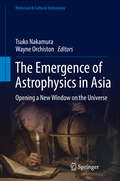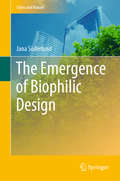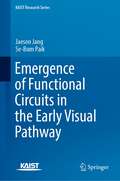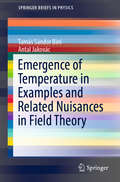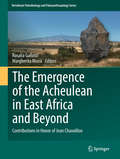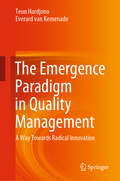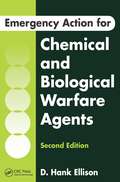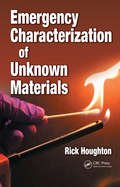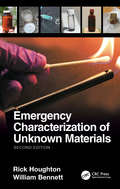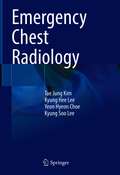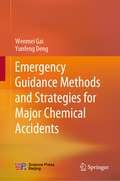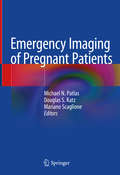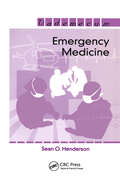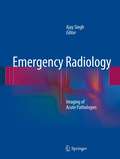- Table View
- List View
The Emergence of Astrophysics in Asia
by Tsuko Nakamura Wayne OrchistonThis book examines the ways in which attitudes toward astronomy in Australia, China, India, Indonesia, Japan, South Korea, New Zealand, Taiwan, Thailand and Uzbekistan have changed with the times. The emergence of astrophysics was a worldwide phenomenon during the late nineteenth and early twentieth centuries, and it gradually replaced the older-style positional astronomy, which focused on locating and measuring the movements of the planets, stars, etc. . Here you will find national overviews that are at times followed by case studies of individual notable achievements. Although the emphasis is on the developments that occurred around 1900, later pioneering efforts in Australian, Chinese, Indian and Japanese radio astronomy are also included. As the first book ever published on the early development of astrophysics in Asia, the authors fill a chronological and technological void. Though others have already written about earlier astronomical developments in Asia, and about the recent history of astronomy in various Asian nations, no one has examined the emergence of astrophysics, the so-called 'new astronomy' in Asia during the late nineteenth and early twentieth centuries.
The Emergence of Biophilic Design (Cities and Nature)
by Jana SöderlundThis book addresses the emergence of biophilic design, a form of design that looks at people’s intrinsic connection with nature. There is no denying that biophilic design is rapidly expanding globally as an effective response to pressing issues in urban areas and built environments. From being a term few had heard of in 2012, when the author’s research began, to one that is currently trending in a broad range of disciplines, the story of its emergence has never been properly told. The story of the emergence of biophilic design is the story of a social movement and how a gathering of people with a common interest and passion can spark a global trend. The book and the stories within are not only engaging but also informative and educational, offering readers an in-depth understanding of what biophilic design is all about, and how to promote its implementation in their own built environment. Hopefully, they will inspire people to act, to campaign and to implement initiatives in their urban environment, with the confidence that they are capable of making a difference. The author spent three years researching the emergence of biophilic design, and why and how it was driven by certain people who championed the concept. Part of the author’s research involved a three-month tour of ten North American cities, during which she interviewed 26 key players. These people ranged from community leaders, landscape architects, and academics, to the CEOs of NGOs and government leaders. The result is a collection of stories that illustrate the evolution of biophilic design, and how it was frequently born from a passion for, belief in and love of nature, as well as a response to an urban crisis.
The Emergence of Eternal Life
by William J. HoyeThe question of whether life exists beyond death remains one of the most pertinent of our existence, and theologians continue to address what relevance the answer has for our life in the present. In this book, William J. Hoye uses the phenomenon of emergence - the way higher forms of existence arise from a collection of simpler interactions - as a framework for understanding and defending the concept of eternal life, showing how it 'emerges' from our present life, our human longing for fulfilment and happiness, and our striving for knowledge of reality. Hoye uses the work of Karl Rahner and Thomas Aquinas to explore questions concerning suffering, the ultimate relevance of morality, and how the fundamental idea of responsibility changes when viewed eschatologically. Contemporary reasons for denying an afterlife are examined critically and extensively. This book will be of great interest to those studying systematic theology, theological anthropology and Catholic theology.
Emergence of Functional Circuits in the Early Visual Pathway (KAIST Research Series)
by Jaeson Jang Se-Bum PaikThis book discusses the emergence of diverse functional organizations in the visual pathway which could be spontaneously and solely initiated by the random feedforward wiring of neural circuits. It demonstrates that the structure of ON and OFF retinal ganglion cell (RGC) mosaics is projected onto V1 by retino-cortical feedforward mapping to induce higher cognitive functions. This book will be beneficial for both theoretical and experimental neuroscientists, as well as for researchers using brain-inspired neural network models.
Emergence of In Vitro 3D Systems to Model Human Malaria
by Kasem KulkeawThis book illustrates the importance and advances of the disease model for malaria, a globally affected public health problem. This book provides comprehensive information on the malaria biology in a liver and all in vitro platforms for liver-stage malaria, including principles, protocols, applications for disease modeling and drug screening, and their limitations. The initial chapter describes the basis of stem cells in liver generation during development and in adults. The subsequent chapters highlight recent and emerging advances in liver organoid and liver-on-a-chip in modeling malaria. The book presents current protocols and methods to generate liver organoid and liver-on-a-chip together with their advantages and limitations. Toward the end, the book examines the humanized mouse model of liver-stage malaria using ectopic artificial livers regarding novel readout modalities. The recent advancement and challenges in combining liver-on-a-chip technology with biosensors are highlighted for assessing hepatocyte development viability and functions. The book elucidates the potential of these 3D models to understand the biological complexity of cellular and molecular mechanisms involved in Plasmodium development in the liver, toolboxes to investigate parasite deployment in the 3D models, and to implement in drug discovery. Finally, the book discusses the future directions and challenges in the applications of liver organoids and liver on-chip in the biology of live-stage malaria. This book is helpful for researchers and scientists in the field of parasitology, cell biology, tissue engineering, and pharmacology.
The Emergence of Indigenous Peoples
by Rodolfo StavenhagenThis is the second part of a trilogy published in the Springer Briefs on Pioneers in Science and Practice on the occasion of the 80th birthday of Rodolfo Stavenhagen, a distinguished Mexican sociologist and professor emeritus of El Colegio de Mexico. Rodolfo Stavenhagen wrote this collection of six essays on The Emergence of Indigenous Peoples between 1965 and 2009. These widely discussed classic texts address: Classes, Colonialism and Acculturation (1965); Indigenous Peoples: An Introduction (2009); The Return of the Native: The Indigenous Challenge in Latin America (2002); Indigenous Peoples in Comparative Perspective (2004); Mexico's Unfinished Symphony: The Zapatista Movement (2000); and Struggle and Resistance: Mexico's Indians in Transition (2006). This volume discusses the emergence of indigenous peoples as new social and political actors at the national and international level. These texts deal with human rights, especially during the years he the author served as United Nations special rapporteur on the rights of indigenous peoples.
The Emergence of Life
by Luisi Pier LuigiThe origin of life from inanimate matter has been the focus of much research for decades, both experimentally and philosophically. Luisi takes the reader through the consecutive stages from prebiotic chemistry to synthetic biology, uniquely combining both approaches. This book presents a systematic course discussing the successive stages of self-organisation, emergence, self-replication, autopoiesis, synthetic compartments and construction of cellular models, in order to demonstrate the spontaneous increase in complexity from inanimate matter to the first cellular life forms. A chapter is dedicated to each of these steps, using a number of synthetic and biological examples. With end-of-chapter review questions to aid reader comprehension, this book will appeal to graduate students and academics researching the origin of life and related areas such as evolutionary biology, biochemistry, molecular biology, biophysics and natural sciences.
The Emergence of Religion in Human Evolution (Routledge Studies in Neurotheology, Cognitive Science and Religion)
by Margaret Boone Rappaport Christopher J. CorballyReligious capacity is a highly elaborate, neurocognitive human trait that has a solid evolutionary foundation. This book uses a multidisciplinary approach to describe millions of years of biological innovations that eventually give rise to the modern trait and its varied expression in humanity’s many religions. The authors present a scientific model and a central thesis that the brain organs, networks, and capacities that allowed humans to survive physically also gave our species the ability to create theologies, find sustenance in religious practice, and use religion to support the social group. Yet, the trait of religious capacity remains non-obligatory, like reading and mathematics. The individual can choose not to use it. The approach relies on research findings in nine disciplines, including the work of countless neuroscientists, paleoneurologists, archaeologists, cognitive scientists, and psychologists. This is a cutting-edge examination of the evolutionary origins of humanity’s interaction with the supernatural. It will be of keen interest to academics working in Religious Studies, Neuroscience, Cognitive Science, Anthropology, Evolutionary Biology, and Psychology.
The Emergence of Spacetime in String Theory (Routledge Studies in the Philosophy of Mathematics and Physics)
by Tiziana VistariniThe nature of space and time is one of the most fascinating and fundamental philosophical issues which presently engages at the deepest level with physics. During the last thirty years this notion has been object of an intense critical review in the light of new scientific theories which try to combine the principles of both general relativity and quantum theory—called theories of quantum gravity. This book considers the way string theory shapes its own account of spacetime disappearance from the fundamental level.
Emergence of Temperature in Examples and Related Nuisances in Field Theory (SpringerBriefs in Physics)
by Antal Jakovác Tamás Sándor BiróField theory, relying on the concept of continuous space and time while confronted with the quantum physical nature of observable quantities, still has some fundamental challenges to face. One such challenge is to understand the emergence of complexity in the behavior of interacting elementary fields, including among other things nontrivial phase structures of elementary matter at high energy density or an atypical emergence of statistical properties, e.g., when an apparent temperature is proportional to a constant acceleration in a homogeneous gravitational field. Most modern textbooks on thermal field theory are mainly concerned with how the field theory formalism should be used if a finite temperature is given. In contrast, this short primer explores how the phenomenon of temperature emerges physically for elementary fields - inquiring about the underlying kinetic field theory and the way energy fluctuations and other noise should be handled - and it investigates whether and how this harmonizes with traditional field theory concepts like spectral evolution, the Keldysh formalism, and phase transitions.
The Emergence of the Acheulean in East Africa and Beyond (Vertebrate Paleobiology And Paleoanthropology Ser.)
by Rosalia Gallotti Margherita MussiThis edited volume presents current archaeological research and data from the major early Acheulean sites in East Africa, and addresses three main areas of focus; 1) the tempo and mode of technological changes that led to the emergence of the Acheulean in East Africa; 2) new approaches to lithic collections, including lithic technology analyses; and 3) the debated coexistence of the Developed Oldowan and the early Acheulean. The chapters are the proceedings from the workshop titled “The Emergence of the Acheulean in East Africa”, held at University of Rome “La Sapienza” on September 12–13, 2013. The aim of the workshop was to bring together researchers currently working in this field in East Africa, in order to define the characteristics and the evolution of the early Acheulean. The volume was expanded with some chapters on the preceding Oldowan, on the African fauna and on paleovegetation, on the Acheulean in Asia and, eventually, on the Acheulean in Europe. The book is addressed to the scientific community, and will be of interest to researchers, graduate students, archaeologists, paleontologists, and paleoanthropologists. This volume is dedicated to the memory of Jean Chavaillon (March 25, 1925 - December 21, 2013), the leading archaeologist and Quaternary geologist who researched with unfailing enthusiasm the earliest human cultures and directed from 1965 to 1995 the French Archaeological Mission at Melka Kunture.
The Emergence Paradigm in Quality Management: A Way Towards Radical Innovation
by Teun Hardjono Everard van KemenadeThis book is focused on quality management, and four different lenses which can be used to explore the phenomenon. It introduces emergence as a paradigm in thinking about quality, and explores conditions which are beneficial to radical innovation. The Emergence Paradigm in Quality Management provides an overview of the existing movements in thinking about quality, and discusses why these movements in fact represent paradigms. Three paradigms, the Empirical Paradigm, the Reference Paradigm and the Reflective Paradigm, are explained followed by a search for the Fourth Paradigm, the so-called Emergence Paradigm, which presents a route to radical innovation in organizations when plans, strategies and models fail. It presents the debates around the paradigms, and explores which is the best approach. This professional text will be ideal for strategy and policy makers wanting to establish a link between their conceived plans and the attention for quality, while finding ways to facilitate innovation. Professionals in a range of for-profit and non-profit organizations, including healthcare, will be able to expand their knowledge on quality management, operations management, and organizational studies.
Emergency Action for Chemical and Biological Warfare Agents
by D. Hank EllisonEmergency Action for Chemical and Biological Warfare Agents, Second Edition is intended for the first responder to the scene of the release of a chemical or biological warfare agent. Formatted similarly to the Department of Transportation‘s Emergency Response Guidebook and designed as a companion to the author‘s Handbook of Chemical and Biological
Emergency Care for Birds: A Guide for Veterinary Professionals
by Rob van ZonDue to their often small size and unique physical characteristics, birds can deteriorate rapidly in the event of illness and injury. Timely intervention in the event of clinical signs is therefore essential for an optimal prognosis. Authored by avian veterinarian Rob van Zon, this concise, practical guide will help veterinary professionals to provide first aid and emergency care for birds, as well as to instruct clients on providing basic first aid when they are unable to get to the clinic. This full-color book, packed with photographs and anatomy drawings, includes instructions for veterinary professionals on stabilizing sick avian patients and management of many specific emergency situations at the veterinary clinic. This includes guidance for those presented with a moribund, critically ill patient i.e., recognizing and treating hypothermia, hypoxia, hypovolemia and hypoglycemia. The book also lists of alarming signs of disease and toxic plants, and includes clinical procedures, an emergency drug formulary, and bandaging techniques. Finally, it offers guidance to veterinarians giving advice to bird owners for first aid at home.
Emergency Characterization of Unknown Materials
by Rick HoughtonDeliberately, accidentally, or consequentially, first responders and waste site workers handle unknown substances of varying degrees of danger every day. Unidentified chemicals involved with clandestine production of WMD agents or drugs, explosive materials, unlabeled waste, and forensic samples all pose a threat to the worker and those they prote
Emergency Characterization of Unknown Materials
by Rick Houghton William BennettEmergency Characterization of Unknown Materials, Second Edition is fully updated to serve as a portable reference that can be used in the field and laboratory by workers who are responsible for a safe response to and management of unknown hazardous materials. As with the first edition, the book emphasizes public safety and the management of life safety hazards, including strategies and emerging technologies to identify the hazards presented by an unknown material. When responding to a hazardous material emergency involving an unknown substance, firefighters and HAZMAT teams are primarily interested in protecting public safety. The book details risk analysis procedures to identify threats and vulnerabilities, analyzing them to determine how such risks can be eliminated or reduced. If an unknown material can be identified with a high degree of confidence, that can considerably change the response, and measures to be taken. In addition, the book covers practical field applications with updated and additional examples of field instruments. The hazard identification methods presented are intended for use by frontline workers. The test methods presented involve manipulation of small sample amounts – using, literally, a hands-on approach. The three technologies used by first responders and military personnel to identify unknown chemicals, Raman spectroscopy, FTIR spectroscopy and high-pressure mass spectroscopy, are covered in depth. Features Presents how to identify unknown materials and, if identification is not possible, to characterize the hazards of the material Offers practical examples to introduce new first responders to hazardous materials response Provides up-to-date field applications of the latest developments in commercially available instrumentation Details practical sample manipulations to help the reader successfully identify materials with popular high-end instrumentation Includes several examples of spectra and describes ways in which the reader can utilize data to inform decision making New coverage to this edition includes a chapter and content that focuses on sample manipulation and separations using instruments developed and revised since the first edition was published. These sample manipulations may be performed in the field with a very simple toolkit, which is fully outlined and explained in detail. Identifying the hazards of the unknown substance is essential to plan for response, contingencies and sustained actions. As such, Emergency Characterization of Unknown Materials, Second Edition will be a welcome and essential resource to all response and safety professionals concerned with hazardous materials.
Emergency Chest Radiology
by Tae Jung Kim Kyung Hee Lee Yeon Hyeon Choe Kyung Soo LeeThis book provides an up-to-date, comprehensive review of every aspect of emergency chest radiology in patients who are admitted to emergency departments with chest trauma or chest pain. The aim is to offer an unsurpassed source of practical information on imaging diagnosis of acutely ill and injured patients with this symptomatology. To this end, the wide spectrum of chest and cardiovascular emergencies are systematically categorized and typical imaging manifestations of these emergent conditions are illustrated in superb detail, with particular attention to the role of state of the art imaging techniques. The book will be an ideal resource for all members of the emergency team, general and emergency radiologists, radiology residents, and medical students.
Emergency Guidance Methods and Strategies for Major Chemical Accidents
by Wenmei Gai Yunfeng DengThis book serves as a great reference for engineering technicians and researchers in a wide range of fields, including emergency management, public safety science, risk management, emergency communication, and transportation optimization. This book carried out researches about the public emergency behavior guidance strategies and methods for major chemical accidents. They put forward the classification model of emergency evacuation events, the selection of public emergency guidance strategies, the quantitative assessment of emergency response risk as well as the characteristics of sub-regional evacuation based on a wide range of theories, including safety engineering, social science, behavioral science, etc. Methods, such as case statistics and analysis, field research as well as modeling and simulation, were applied. Five chapters were covered by the book, including introduction of study background, statistics and analysis of hazardous chemical leakage accidents and emergency evacuation response in China in recent ten years, shelter-in-place risk assessment for high-pressure natural gas wells with hydrogen sulphide, dynamic emergency route planning, and characteristics analysis of sub-regional evacuation.
Emergency Imaging of Pregnant Patients
by Michael N. Patlas Douglas S. Katz Mariano ScaglioneThis book presents a comprehensive and modern approach to the imaging of nontraumatic and traumatic emergencies in pregnant patients. Readers will find a careful review of the relevant imaging-related clinical literature, explanation of imaging appropriateness criteria and guidelines, and enlightening discussion of current controversies in the emergency imaging of obstetric patients. The opening chapter discusses general principles of emergency imaging during pregnancy and offers an overview of an evidence-based approach to imaging interpretation. The remainder of the book describes specific applications of ultrasound, MRI, radiography, and MDCT for the imaging of common as well as less common acute brain, spine, thoracic, abdominal, and pelvic conditions during pregnancy. Clear guidance is offered on the unique challenges that may be encountered during such imaging. Emergency Imaging of Pregnant Patients is written by a group of leading North American and European emergency and trauma radiology experts. It will be of value to emergency and general radiologists, to emergency department physicians and related personnel, to obstetricians and gynecologists, to general and trauma surgeons, and to trainees in all of these specialties.
Emergency Management and Social Intelligence: A Comprehensive All-Hazards Approach
by Charna R. Epstein Ameya Pawar Scott. C. SimonFor effective preparedness, emergency managers must comprehend how a disaster impacts not only the physical infrastructure of the affected community but also the population. They must understand how the people interact with one another, how they interact with government, and how they react to the disaster event. In other words, they must have socia
Emergency Medicine
by Sean HendersonThis book contains core Emergency Medicine information in an abbreviated, succinct form, useful to house staff and medical students.
Emergency Planning Guide for Utilities
by Jérôme Pagès Samuel Mullen Francois LeAn increase in major natural disasters has led to heightened concerns about utility operations and public safety. Due to today's complex, compliance-based environment, utility managers and planners often find it difficult to plan for the action needed to help ensure organization-wide resilience and meet consumer expectations during these incidents. This volume offers a working guide that presents new and field-tested approaches to plan development, training, exercising, and emergency program management. The book will help utility planners, trainers, and responders to more effectively prepare for damaging events and improve the level of the utility‘s resilience.
Emergency Radiology
by Ajay SinghIn the emergency and trauma setting, accurate and consistent interpretation of imaging studies are critical to the care of acutely ill and injured patients. Emergency Radiology: Imaging of Acute Pathologies is a comprehensive review of radiological diagnoses commonly encountered in the emergency room by radiologists, residents, and fellows. The book is organized by anatomical sections that present the primary ER imaging areas of the acute abdomen, pelvis, thorax, neck, head, brain and spine, and osseous structures. For each section, the common diagnoses are concisely described and are accompanied by relevant clinical facts and key teaching points that emphasize the importance of radiological interpretation in clinical patient management. The role of modalities such as plain radiography, CT, ultrasound, MR, and nuclear medicine imaging in managing emergency conditions is highlighted.
Emergency Radiology of the Abdomen
by Gerd Schueller Mariano Scaglione Ulrich LinsenmaierThe term "acute abdomen" refers to a serious, often progressive clinical situation that calls for immediate diagnostic and therapeutic action. Today, diagnosis via imaging has basically replaced the physical examination in the emergency room and the Radiologist has become of primary importance in this setting. However, close co-operation among the various specialists involved is essential for successful patient management, and thus the Radiologist needs to have a full understanding of the imaging modalities and technical skills required, as well as appropriate clinical knowledge of the disorder in order to manage the condition. This book provides a comprehensive review of the multifaceted etiology, pathophysiology and clinical presentation of acute abdominal conditions, focusing on the imaging features that are relevant to a timely management approach. Numerous high-quality images, diagrams and easy-to-read tables are provided.
Emergency Response and Hazardous Chemical Management: Principles and Practices
by Clyde B. Strong T. Rick IrvinManagement of hazardous chemicals and materials-particularly during emergency release situations-is a critical part of routine training required for workers and professionals in the chemical, petroleum and manufacturing industries. Proper storage of highly reactive chemical agents, correct choice of protective clothing and safety issues in confined
